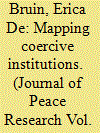|
|
|
Sort Order |
|
|
|
Items / Page
|
|
|
|
|
|
|
| Srl | Item |
| 1 |
ID:
115728


|
|
|
|
|
| Publication |
2012.
|
| Summary/Abstract |
Previous studies have attested to leaders "coup-proofing" their regimes by reducing the ability or disposition of their armies to seek their removal. The following article tests the utility of these efforts. "Structural" coup-proofing such as counterbalancing is expected to reduce the ability to organize a coup plot by creating substantial coordination obstacles to soldiers. Coup-proofing by spoiling militaries with organizational resources is expected to reduce the willingness to intervene. However, increased organizational resources are expected to increase the army's capabilities, thereby increasing the likelihood of a coup's success. The theory is empirically tested using a selection model with a global sample from 1961 to 2000. Findings suggest that both coup-proofing strategies are effective deterrents of coup activity and, more generally, that characteristics of the military appear to be far more important than economic influences on coups.
|
|
|
|
|
|
|
|
|
|
|
|
|
|
|
|
| 2 |
ID:
178688


|
|
|
|
|
| Summary/Abstract |
How rulers organize and use their security forces is thought to have important implications for regime survival, repression, and military effectiveness. While a number of studies provide insight into the coercive institutions of individual states, efforts to understand systematic patterns have been hampered by a lack of reliable data on state security forces that can be compared across states and within them over time. This article presents the State Security Forces (SSF) dataset, which includes 375 security forces in 110 countries, 1960–2010. It tracks how each force is commanded, staffed, equipped, and deployed, as well as the number of security forces and potential counterweights in each state’s security sector as a whole. After illustrating how the SSF dataset differs from related ones and presenting descriptive trends, the article shows how it can be used to deepen our understanding of coup-proofing and strategic substitution, and identifies additional research uses of the dataset.
|
|
|
|
|
|
|
|
|
|
|
|
|
|
|
|
| 3 |
ID:
121819


|
|
|
|
|
| Publication |
2013.
|
| Summary/Abstract |
Uganda suffered coups between 1966 and 1985, but has remained stable since 1986 despite predisposition to previous coups. Ethnic antagonism, weak state institutionalization, and past coups, had made Uganda coup-prone. Compared to previous governments, the post-1986 leadership effectively applied and undertook coup-prevention strategies consistent with James Quinlivan's coup-proofing theory. These include establishing a parallel military structure to the mainstream military; formation of security services with parallel reporting channels, monitoring over society, and other security agencies; and co-optation of the military in politics through parliamentary representation. These measures have helped the regime to watch over security agencies and prevent possible military intervention. Uganda's post-1986 regime stability is interesting in its own right. But it provides evidence consistent with, and useful for testing the efficacy of, Quinlivan's coup-proofing theory: with relevant application and domestication the theory applies to Uganda.
|
|
|
|
|
|
|
|
|
|
|
|
|
|
|
|
| 4 |
ID:
120293


|
|
|
|
|
| Publication |
2013.
|
| Summary/Abstract |
The following special issue on the role of armed forces focuses on what explains the considerable variation in both how these uprisings played themselves out and their political outcomes. At least three basic dimensions - duration, political intensity and the magnitude of violence - the variation Between the six states covered in this issue - Egypt, Syria, Libya, Tunisia, Yemn and Bahrain - has been considerable even on a proportionate basis. The range of political outcomes within these six cases has been considerable, ranging from a more or less stable transition to democracy in Tunisia to the Syrian case where there is considerable fear that Syria will break up into sectarian mini-states.
|
|
|
|
|
|
|
|
|
|
|
|
|
|
|
|
|
|
|
|
|